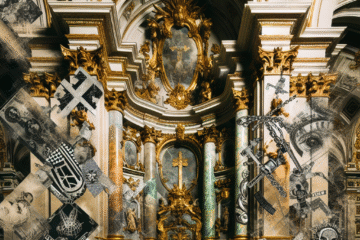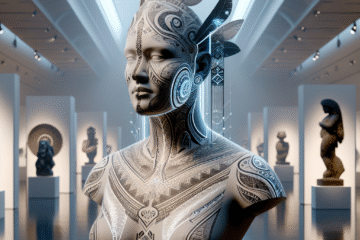
“
Luck is what happens when preparation meets opportunity.
”
— Seneca the Younger
From Atom to Abstract: Quantum Physics Meets Color Field Painting
Introduction: When Color Meets the Quantum Field
In the mid-20th century, two seemingly disjoint disciplines—abstract painting and quantum physics—were undergoing seismic shifts. On one hand, artists like Mark Rothko, Barnett Newman, and Clyfford Still were forging new visual languages in the aftermath of war and existential uncertainty. On the other, physicists were deconstructing the physical universe into a probabilistic dance of particles and fields. While seemingly unrelated, the conceptual crosscurrents between these realms run deeper than one might expect. Both spoke the language of intangibility, fields, and perception—suggesting that abstraction and modern physics were, in their own ways, poetic responses to a changing reality.
Chapter 1: The Rise of Color Field Painting – Beyond Form and Figure
Emerging out of the Abstract Expressionist movement in postwar America, Color Field painting represented a leap from action to atmosphere. Artists like Rothko and Newman moved away from the gestural bravado of Jackson Pollock to embrace vast, contemplative surfaces of pure color. These swaths were not merely pigment—they were emotional ecosystems. Rothko’s floating rectangles and Newman’s ‘zips’ aimed to transcend narrative, instead inviting viewers into immersive zones of experience.
It was art that demanded stillness, much like how quantum physics operates in the realm of the unseen. Form was obliterated; energy was everything. Color became the vehicle of spiritual transcendence, mirroring the new scientific notion that what we perceive as solid ‘matter’ is actually energy vibrating in fields.
Chapter 2: Quantum Mechanics – The Breakdown of Certainty
Quantum mechanics, revolutionized in the early 20th century by luminaries like Niels Bohr, Werner Heisenberg, and Erwin Schrödinger, dismantled classical Newtonian ideas. Suddenly, particles were waves, and observation influenced reality. Space was no longer a static arena but a dynamic field of latent possibilities. The very act of perception became participatory: to observe was to alter the observed.
This directly parallels the way Color Field artists like Newman approached the viewer. His monumental works were not made to be ‘looked at’ but to be experienced. The viewer, in turn, became part of the artwork’s field—emotionally, existentially, and even spiritually—echoing the participatory nature of measurement in quantum theory.
Chapter 3: Presence, the Sublime, and the Field
Barnett Newman’s invocation of the ‘Sublime’ wasn’t mere romanticism—it was a philosophical stance. In his famous writings like “The Sublime is Now,” Newman spoke of stripping art down to the experience of existence itself. Likewise, quantum theorists were grappling with a universe where even emptiness pulsed with energetic potential. The idea of a “field”—a continuous entity defining the behavior of energy over space and time—is central to both Color Field painting and quantum field theory.
Indeed, when standing before a Rothko, many report a physical reaction—a sense of time expanding or dissolving. Today, cognitive neuroscience might attribute this to perceptual saturation and the brain’s interpretation of infinite space, but spiritually and metaphorically, it resonates with quantum entanglement: the mysterious interconnectedness of seemingly separate realities.
Chapter 4: The Cultural Zeitgeist – After War, the Invisible Matters
Both Color Field painting and quantum physics matured in the crucible of the Cold War, a time rife with anxiety, existential dread, and a gnawing awareness of unseen forces—atomic energy, political ideologies, and looming destruction. What better art for this age than one which addressed the immaterial and the ineffable? No longer could surface and form satisfy humanity’s deeper questions.
Technological advancements, especially those related to nuclear physics, reframed the way people thought about nature. The invisible became not only real but also potent. Art mirrored this transition; it turned inward and magnified the non-material. Color Field painting became a symbol of both individual isolation and collective transcendence—just as quantum fields represent both singularity and universality.
Chapter 5: Contemporary Reflections – Legacy and Continuum
Today, the dialogue between art and science continues to unfold. Contemporary artists and physicists alike are inspired by the same mysteries: the nature of consciousness, time, space, and perception. Digital artists inspired by Rothko now explore immersive installations akin to quantum environments where data, color, and light interact unpredictably. At large, the ethos of the Color Field persists in minimalist architecture, meditative spatial design, and even screen-based visual culture—spaces designed to evoke presence and contemplation.
Ultimately, both disciplines challenge our assumptions about reality. The Color Field painters demanded we feel rather than know; physicists suggest that knowing is, itself, a form of influence. ‘From Atom to Abstract’ is not merely a metaphor—it’s a map of modernity’s internal landscape, endlessly unfolding across color and quark alike.

Image description:
Screenshot of a new media artwork by Michael Demers.
License:
CC BY-SA 3.0
Source:
Wikimedia Commons


